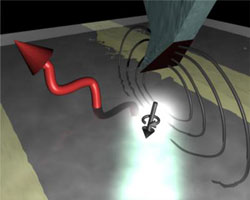UC Santa Barbara researcher's new study may lead to MRIs on a nanoscale

The magnetic field emanating from a mechanical resonator affects the quantum state of a nitrogen vacancy center in diamond. Credit: Quirin Unterreithmeier<br>
Ania Bleszynski Jayich, an assistant professor of physics who joined the UCSB faculty in 2010, spent a year at Harvard working on an experiment that coupled nitrogen-vacancy centers in diamond to nanomechanical resonators. That project is the basis for the new paper, “Coherent sensing of a mechanical resonator with a single spin qubit.”
A nitrogen-vacancy (NV) center is a specific defect in diamond that exhibits a quantum magnetic behavior known as spin. When a single spin in diamond is coupled with a magnetic mechanical resonator –– a device used to generate or select specific frequencies –– it points toward the potential for a new nanoscale sensing technique with implications for biology and technology, Jayich explained.
Among those possible future applications of such a technique is magnetic resonance imaging on a scale small enough to image the structure of proteins –– an as-yet unaccomplished feat that Jayich called “one of the holy grails of structural biology.”
“The same physics that will allow the NV center to detect the magnetic field of the resonator, hopefully, will allow MRI on the nanoscale,” Jayich said. “It could make MRI more accurate, and able to see more. It's like having a camera with eight megapixels versus one with two megapixels and taking a picture of someone's face. You can't see features that are smaller than the size of a pixel. So do they have three freckles, or do they all look like one big freckle?
“That's the idea,” Jayich continued. “To resolve individual freckles, so to speak, to see what a protein is made up of. What we found in this paper suggests that it is possible, although a significant amount of work still needs to be done.”
Though further into the future based on the approach used for this paper, Jayich said, there is also the potential for such a coupling to be advanced and exploited as a possible route toward the development of a hybrid quantum system, or quantum computer.
Jayich collaborated on the project with researchers Shimon Kolkowitz, Quirin Unterreithmeier, Steven Bennett, and Mikhail Lukin, all from Harvard; Peter Rabl, from the Institute for Quantum Optics and Quantum Information of the Austrian Academy of Science; and J.G.E. Harris, from Yale. The work was supported in part by the National Science Foundation, the Center for Ultracold Atoms, and the Packard Foundation.
Media Contact
More Information:
http://www.ucsb.eduAll latest news from the category: Physics and Astronomy
This area deals with the fundamental laws and building blocks of nature and how they interact, the properties and the behavior of matter, and research into space and time and their structures.
innovations-report provides in-depth reports and articles on subjects such as astrophysics, laser technologies, nuclear, quantum, particle and solid-state physics, nanotechnologies, planetary research and findings (Mars, Venus) and developments related to the Hubble Telescope.
Newest articles

Properties of new materials for microchips
… can now be measured well. Reseachers of Delft University of Technology demonstrated measuring performance properties of ultrathin silicon membranes. Making ever smaller and more powerful chips requires new ultrathin…

Floating solar’s potential
… to support sustainable development by addressing climate, water, and energy goals holistically. A new study published this week in Nature Energy raises the potential for floating solar photovoltaics (FPV)…

Skyrmions move at record speeds
… a step towards the computing of the future. An international research team led by scientists from the CNRS1 has discovered that the magnetic nanobubbles2 known as skyrmions can be…





















